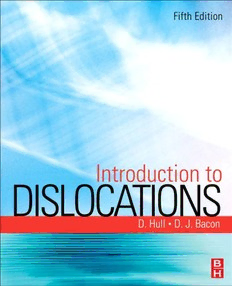
Introduction to Dislocations PDF
Preview Introduction to Dislocations
Introduction to Dislocations This page intentionally left blank Introduction to Dislocations Fifth Edition D. Hull and D. J. Bacon Department of Engineering, MaterialsScience and Engineering, University ofLiverpool, UK Amsterdam(cid:1)Boston(cid:1)Heidelberg(cid:1)London(cid:1)NewYork(cid:1)Oxford Paris(cid:1)SanDiego(cid:1)SanFrancisco(cid:1)Singapore(cid:1)Sydney(cid:1)Tokyo Butterworth-HeinemannisanimprintofElsevier Butterworth-HeinemannisanimprintofElsevier TheBoulevard,LangfordLane,Kidlington,Oxford,OX51GB 30CorporateDrive,Suite400,Burlington,MA01803,USA Firstpublished1965 Secondedition1975 Thirdedition1984 Fourthedition2001 Reprinted2002,2004,2005,2006,2007,2009(twice) Fifthedition2011 Copyrightr2011D.HullandD.J.Bacon.PublishedbyElsevierLtd.Allrightsreserved TherightofD.HullandD.J.Bacontobeidentifiedastheauthorsofthisworkhasbeenassertedinaccordancewiththe Copyright,DesignsandPatentsAct1988 Nopartofthispublicationmaybereproducedortransmittedinanyformorbyanymeans,electronicormechanical, includingphotocopying,recording,oranyinformationstorageandretrievalsystem,withoutpermissioninwritingfromthe Publisher.Detailsonhowtoseekpermission,furtherinformationaboutthePublisher’spermissionspoliciesandour arrangementswithorganizationssuchastheCopyrightClearanceCentreandtheCopyrightLicensingAgency,canbefound atourwebsite:www.elsevier.com/permissions. ThisbookandtheindividualcontributionscontainedinitareprotectedundercopyrightbythePublisher (otherthanasmaybenotedherein) Notices Knowledgeandbestpracticeinthisfieldareconstantlychanging.Asnewresearchandexperiencebroadenour understanding,changesinresearchmethods,professionalpractices,ormedicaltreatmentmaybecomenecessary. Practitionersandresearchersmustalwaysrelyontheirownexperienceandknowledgeinevaluatingandusingany information,methods,compounds,orexperimentsdescribedherein.Inusingsuchinformationormethodstheyshouldbe mindfuloftheirownsafetyandthesafetyofothers,includingpartiesforwhomtheyhaveaprofessionalresponsibility. Tothefullestextentofthelaw,neitherthePublishernortheauthors,contributors,oreditors,assumeanyliabilityforany injuryand/ordamagetopersonsorpropertyasamatterofproductsliability,negligenceorotherwise,orfromanyuseof operationofanymethods,products,instructions,orideascontainedinthematerialherein. BritishLibraryCataloguing-in-PublicationData AcataloguerecordforthisbookisavailablefromtheBritishLibrary LibraryofCongressCataloging-in-PublicationData AcatalogrecordforthisbookisavailablefromtheLibraryofCongress ISBN:978-0-08-096672-4 ForinformationonallButterworth-Heinemannpublications visitourwebsiteatwww.elsevierdirect.com TypesetbyMPSLimited,aMacmillanCompany,Chennai,India www.macmillansolutions.com PrintedandboundinGreatBritain 1112131415 10987654321 Contents PREFACE...................................................................................................ix CHAPTER 1 Defects in Crystals............................................................1 1.1 CrystallineMaterials.............................................................1 1.2 SimpleCrystalStructures.....................................................4 1.3 DefectsinCrystallineMaterials...........................................8 PointDefects.........................................................................8 StackingFaults....................................................................10 GrainBoundaries................................................................12 TwinBoundaries.................................................................12 VolumeDefects...................................................................13 1.4 Dislocations.........................................................................13 GeometryofDislocations...................................................15 BurgersVectorandBurgersCircuit..................................16 FurtherReading.........................................................................20 CHAPTER 2 Observation ofDislocations...........................................21 2.1 Introduction.........................................................................21 2.2 ElectronMicroscopy............................................................22 GeneralPrinciples...............................................................22 Dislocations.........................................................................24 PlanarDefects.....................................................................25 LatticeImaging...................................................................26 ImageSimulation................................................................26 OtherFactors......................................................................28 2.3 OtherExperimentalMethods.............................................28 SurfaceMethods.................................................................28 DecorationMethods............................................................30 X-rayDiffractionTopography............................................31 FieldIonMicroscopyandAtom ProbeTomography.............................................................32 v vi Contents 2.4 ComputerSimulation..........................................................34 Atomic-LevelSimulation....................................................34 Continuum-LevelSimulation..............................................38 FurtherReading.........................................................................41 CHAPTER 3 Movement ofDislocations..............................................43 3.1 ConceptofSlip....................................................................43 3.2 DislocationsandSlip...........................................................45 3.3 TheSlipPlane......................................................................46 3.4 CrossSlip.............................................................................48 3.5 VelocityofDislocations.......................................................50 3.6 Climb....................................................................................53 3.7 ExperimentalObservationofClimb...................................56 PrismaticDislocationLoops...............................................56 HelicalDislocations.............................................................57 3.8 ConservativeClimb.............................................................59 3.9 PlasticStrainduetoDislocationMovement.....................59 FurtherReading.........................................................................61 CHAPTER 4 ElasticProperties of Dislocations...................................63 4.1 Introduction.........................................................................63 4.2 ElementsofElasticityTheory............................................63 4.3 StressFieldofaStraightDislocation.................................67 ScrewDislocation................................................................67 EdgeDislocation.................................................................69 4.4 StrainEnergyofaDislocation............................................71 4.5 ForcesonDislocations........................................................73 4.6 ForcesbetweenDislocations..............................................75 4.7 ClimbForces........................................................................79 4.8 ImageForces.......................................................................81 FurtherReading.........................................................................82 CHAPTER 5 Dislocations in Face-centered Cubic Metals.................85 5.1 PerfectDislocations.............................................................85 5.2 PartialDislocations(cid:1)TheShockleyPartial......................85 5.3 Slip........................................................................................87 5.4 Thompson’sTetrahedron...................................................93 5.5 FrankPartialDislocation.....................................................94 5.6 DislocationLocksandStair-RodPartials...........................99 5.7 StackingFaultTetrahedra................................................103 FurtherReading.......................................................................107 Contents vii CHAPTER 6 Dislocations inOther CrystalStructures.....................109 6.1 Introduction.......................................................................109 6.2 DislocationsinHexagonalClose-packedMetals............109 BurgersVectorsandStackingFaults..............................109 BasalandNon-basalSlip..................................................112 VacancyandInterstitialLoops........................................115 6.3 DislocationsinBody-centeredCubicMetals..................118 6.4 DislocationsinIonicCrystals...........................................124 6.5 DislocationsinSuperlattices............................................126 6.6 DislocationsinCovalentCrystals....................................130 6.7 DislocationsinLayerStructures......................................133 6.8 DislocationsinPolymerCrystals......................................134 FurtherReading.......................................................................135 CHAPTER 7 Jogs and theIntersection of Dislocations...................137 7.1 Introduction.......................................................................137 7.2 IntersectionofDislocations..............................................137 7.3 MovementofDislocationsContaining ElementaryJogs................................................................139 7.4 Superjogs...........................................................................142 7.5 JogsandPrismaticLoops.................................................145 7.6 IntersectionsofExtendedDislocationsand ExtendedJogs...................................................................147 7.7 AttractiveandRepulsiveJunctions.................................149 7.8 ExtendedStacking-faultNodes........................................153 FurtherReading.......................................................................155 CHAPTER 8 Origin and Multiplication of Dislocations....................157 8.1 Introduction.......................................................................157 8.2 DislocationsinFreshlyGrownCrystals..........................158 8.3 HomogeneousNucleationofDislocations.......................159 8.4 NucleationofDislocationsatStressConcentrators........160 8.5 MultiplicationofDislocationsby Frank(cid:1)ReadSources.........................................................163 8.6 MultiplicationbyMultipleCrossGlide...........................166 8.7 MultiplicationbyClimb....................................................167 8.8 GrainBoundarySources...................................................169 FurtherReading.......................................................................169 CHAPTER 9 Dislocation Arrays and CrystalBoundaries................171 9.1 PlasticDeformation,RecoveryandRecrystallization.....171 9.2 SimpleDislocationBoundaries.........................................175 9.3 GeneralLow-angleBoundaries........................................177 viii Contents 9.4 StressFieldofDislocationArrays....................................181 9.5 StrainEnergyofDislocationArrays.................................184 9.6 DislocationsandStepsinInterfaces................................186 AdmissibleDefects...........................................................186 IdentificationofInterfacialDislocations.........................189 DislocationsinEpitaxialInterfaces.................................191 9.7 MovementofBoundaries..................................................193 ArraysofCrystalDislocations..........................................193 GlideofInterfacialDefects...............................................195 Diffusion-assistedMotionofInterfacialDefects.............199 MartensiticTransformations............................................201 9.8 DislocationPile-ups...........................................................203 FurtherReading.......................................................................204 CHAPTER 10 Strength ofCrystalline Solids.......................................205 10.1 Introduction.....................................................................205 10.2 Temperature-andStrain-Rate-Dependenceof theFlowStress................................................................207 10.3 ThePeierlsStressandLatticeResistance....................210 DislocationCoreStructure.............................................210 ThePeierlsBarrier..........................................................213 KinkMechanism.............................................................214 10.4 InteractionBetweenPointDefectsandDislocations...216 10.5 SoluteAtmospheresandYieldPhenomena..................220 DislocationLocking.........................................................220 YieldDrop........................................................................224 IrradiationHardeningandDislocationChanneling.....227 10.6 TheFlowStressforRandomArraysofObstacles........228 DiffuseForces..................................................................229 LocalizedForces..............................................................230 10.7 TheStrengthofAlloys....................................................232 Solutions,PrecipitatesandAging.................................232 SolutionStrengthening...................................................233 PrecipitateStrengthening..............................................235 10.8 WorkHardening..............................................................237 10.9 DeformationofPolycrystals............................................243 10.10 DislocationsandFracture...............................................245 FurtherReading.........................................................................248 THE SI SYSTEM OFUNITS...................................................................251 INDEX.....................................................................................................253 Preface We are delighted to introduce the fifth edition of this book, which was first published in 1965 and has been in press continuously since then. In the Preface to the first edition it was noted that “Although many aspects of the applicationof dislocation ideas are still in astate of flux abody of knowledge, based on theoretical analysis and experimental observation, has now been established which forms a basis for most of the ideas and theories which are proposed”. Today the subject is a well-established discipline and is a powerful and essential aspect in understanding of the propertiesand behavior of crystalline solids. Much of the basis of the subject, set out in relatively simple terms in the first edition, has been retained in later editions. In each subsequent edition new material has been included to broaden the detail and introduce some key aspects, which have emerged from research, without turning the book into a research monograph. In this latest edition we have taken advantage of recent research, using advanced computer modeling and very high resolution elec- tron microscopy, to provide a better understanding of the arrangement of atoms close to the centre or core of dislocations. It is now clear that the atomic arrangement in the core has a fundamental effect on the behavior of dislocations and thereby on the propertiesof solids. The development of this edition has benefited from a worldwide consulta- tion, bythe publishers, withleading authorities inthe teaching and research- ing of dislocations. This consultation established that the fourth edition is still widely used in undergraduate and post-graduate university science and engineering courses and research schools. In preparing the fifth edition we have attempted to maintain a balance between a description of the basic properties of dislocations that are taught in introductory undergraduate coursesand amore detailedtreatment thatis required for scientific research. This distinction depends on the nature of courses and research although we have not attempted to make any delineation within the body of the text. Thus, for example, in Chapter 2, on the observation of dislocations, the sim- ple methods, first developed in early studies, are set alongside the ix
